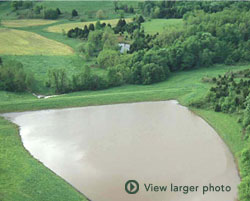About EAPs
An EAP is Thorough, Updated and Tested
An Emergency Action Plan (EAP) is a formal document that identifies potential emergency conditions at a dam and specifies preplanned actions to be followed to minimize property damage and loss of life should those conditions occur. The EAP contains procedures and information to assist the dam owner in issuing early warning and notification messages to responsible downstream emergency management authorities. It also should contain inundation maps to show the emergency management authorities the critical areas for action in case of an emergency.

To guide dam owners and emergency managers in development of EAPs on HHP dams, North Carolina's Dam Safety Program has created a new EAP template (form) that can be used for any size dam. In designing the template, EAP forms and formats from several states and from federal agencies were reviewed, along with lessons learned from actual emergencies at dams in North Carolina and elsewhere. For example, the template draws on some elements from Federal Guidelines for Dam Safety: Emergency Action Planning for Dam Owners (an update of the document FEMA 64). Although the North Carolina template is 68 pages in length, several pages contain explanations of terminology and others are most appropriate for larger dams. The North Carolina template is meant to be user friendly and the resulting EAP may be shorter, depending on the characteristics of the dam and its inundation zone.
The general purpose of these guidelines from the Federal Emergency Management Agency is to encourage thorough and consistent emergency action planning. An emergency in terms of dam operation is defined as an impending or actual sudden release of water caused by an accident to, or failure of, a dam or other water retaining structure, or the result of an impending flood condition when the dam is not in danger of failure.
Organizations and individuals who own or are responsible for the operation and maintenance of dams are encouraged to use these guidelines to develop, update, and/or revise their EAPs. EAPs generally contain six basic elements:
- Notification Flowchart
- Emergency Detection, Evaluation, and Classification
- Responsibilities
- Preparedness
- Inundation Maps
- Appendices
All of the elements should be included in a complete EAP. The dam owner is responsible for the development of the EAP. However, the development or revision of an EAP must be done in coordination with those having emergency management responsibilities at the state and local levels. Emergency management agencies will use the information in a dam owner's EAP to facilitate the implementation of their responsibilities. State and local emergency management authorities will generally have some type of plan in place, either a Local Emergency Operations Plan (EOP) or a Warning and Evacuation Plan.

A typical PL-566 dam that may now
be HHP due to the residence below the dam.
Like an EOP, an EAP for a dam should establish procedures (duties, responsibilities and actions) for emergency response such as warning the public and other functions. The EAP development process should contain a functional format that spells out the Who, With What, and How of all critical emergency functions in time of disaster. Dam failures have unique considerations that require specific planning, such as the inundation mapping.
The effectiveness of EAPs can be enhanced by promoting a uniform format which ensures that all aspects of emergency planning are covered in each plan. Uniform EAPs and advance coordination with local and state emergency management officials and organizations should facilitate a timely response to a developing or actual emergency situation.
The U.S. Department of Agriculture is another federal agency that has a major role in dam safety and emergency planning. North Carolina has hundreds of dams that were built as small watershed projects under the 1953 Public Law 566, and most are getting old and in need of more frequent inspection and repair. USDA's Natural Resources Conservation Service works with sponsors/owners of these dams, many of which fall under state regulation. NRCS has created guidelines and templates for EAPs.
NRCS has posted its own EAP form, which details a NRCS Directive that guides NRCS staff, dam owners, and emergency response authorities in completing an EAP. NRCS staff are available to help dam owners in preparing their EAP.
